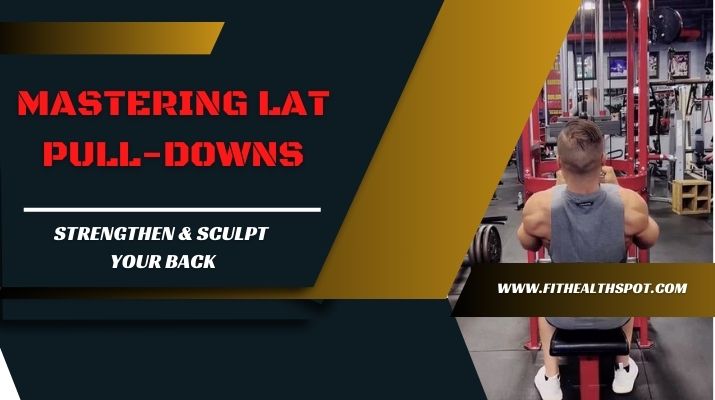Introduction to the Lat Pulldown
The Lat Pulldown, a cornerstone exercise in fitness and bodybuilding, offers a unique blend of upper body strength and muscle development that few exercises can match. The Lat Pulldown, at its essence, zeroes in on the mighty latissimus dorsi, that sprawling back muscle whose formidable presence not only bestows upon it the moniker but also elevates it to a position of unparalleled acclaim within the sacred temples of iron worldwide.
The Lat Pulldown holds paramount importance for those keen on building a powerful and defined upper body. But it’s not just about aesthetics. Incorporating this exercise into your routine translates into functional strength that aids in various everyday activities, from lifting heavy objects to maintaining an upright posture.
It’s no surprise that professional athletes, bodybuilders, and even those just starting their fitness journey often integrate the Lat Pulldown into their regimen. Its ability to target a range of muscles beyond just the lats makes it versatile, allowing for better posture, enhanced shoulder stability, and a balanced upper-body physique.
But why is this exercise so revered in the fitness realm? The Lat Pulldown is a rare exercise that caters to beginners and seasoned gym-goers. It is an excellent introduction to back training for novices, offering a controlled environment to learn form and technique. For the experienced, it’s an opportunity to isolate and intensively work on the lat muscles, refining the V-shaped taper that many desire.
The importance of the Lat Pulldown cannot be overstated. Whether you aim to build muscle, enhance strength, or simply lead a healthier lifestyle, this exercise is a testament to how traditional exercises can offer unparalleled benefits when done correctly.
Interested in further expanding your knowledge on back exercises? Dive deep into the different variants of Lat Pulldowns and their intricate details with our comprehensive guide here.
The Basics: How to do a Lat Pulldown
Before diving into the numerous variants of the Lat Pulldown, it’s crucial to nail down the fundamentals of the classic movement. Ensuring you’ve got the basics right optimizes muscle engagement and significantly reduces the risk of injuries. Here’s a step-by-step breakdown:
Proper Setup Before Starting
- Choosing the Right Weight: Begin by selecting a weight on the pulldown machine that’s challenging yet allows for full motion without compromising on form. Embark upon your journey with the gentlest of burdens, letting your might and self-assurance burgeon ere you bear the weightier load.
- Adjusting the Thigh Pads: The machine’s thigh pads should be adjusted to sit snugly over your thighs. This prevents you from lifting off the seat when pulling the weight and ensures you’re securely anchored.
- Choosing the Right Weight: Begin by selecting a weight on the pulldown machine that’s challenging yet allows for full motion without compromising on form. Embark upon your journey with the gentlest of burdens, letting your might and self-assurance burgeon ere you bear the weightier load.
- Adjusting the Thigh Pads: The machine’s thigh pads should be adjusted to sit snugly over your thighs. This prevents you from lifting off the seat when pulling the weight and ensures you’re securely anchored.
- Seat Position: Ensure the seat is adjusted so your feet are flat. A stable base is vital for effective force transmission and stability throughout the exercise.
Positioning and Posture
- Grip Width: Grab the bar wider than shoulder-width apart. Your hands should be positioned where the bar starts to bend. This grip allows for optimal lat activation.
- Grip Type: Utilize an overhand (pronated) grip with your palms facing forward.
- Posture: Sit tall with a slight arch in your lower back. Engage your core muscles and retract your shoulder blades slightly. This posture ensures maximum muscle engagement and reduces strain on the spine.
The Correct Motion and Breathing Techniques
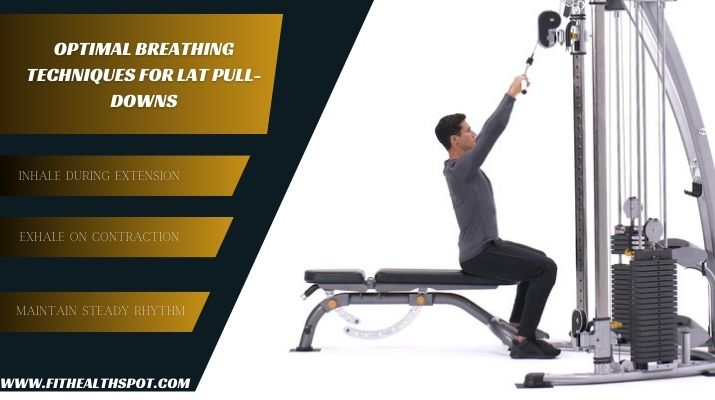
- Initiating the Pull: Begin by driving your elbows down and back, focusing on squeezing your shoulder blades together. The motion should be smooth, with the bar moving towards the top of your chest.
- The Return Phase: Slowly release the weight back to the starting position, allowing for a controlled stretch of the lat muscles. Avoid letting the weights crash or using momentum.
- Breathing Technique: Inhale during the initial relaxed position and exhale as you pull the bar down. Exhaling during the effort phase provides additional core stability and power.
Performing the Lat Pulldown ensures you’re making the most out of every rep. It’s not about how much weight you can pull; it’s about activating and working the target muscles correctly.
For those eager to venture beyond the basics and explore more targeted exercises for the wrist, our complete guide on wrist curls can provide insights. Check it out here.
Diving Deep into the Variants
Reverse Grip Lat Pulldown (also known as Underhand Lat Pulldown)
In back workouts, changing your grip can completely shift the muscles you target. The Reverse Grip Lat Pulldown, often called the Underhand Lat Pulldown, is a prime example.
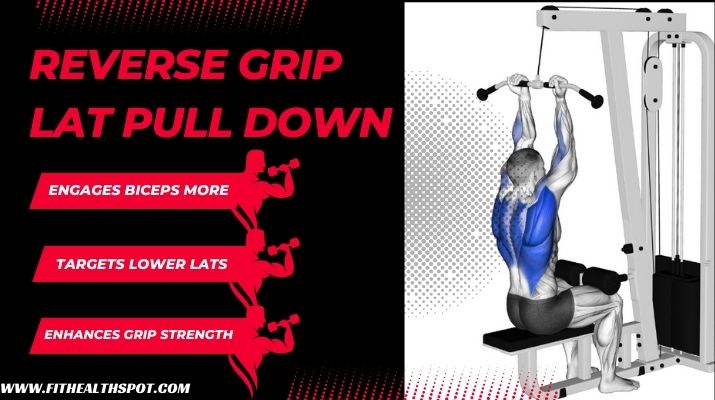
The Unique Benefits of This Grip:
- Enhanced Bicep Activation: The underhand grip naturally engages the biceps more than the traditional overhand grip. This offers an added advantage for those working on their arm muscles while targeting their lats.
- Increased Range of Motion: This grip allows for a more extended contraction at the bottom of the movement, ensuring the lats get a more comprehensive workout.
- Focused Lower Lat Activation: In the quest for sculpting a standout physique, the reverse grip swoops in to shine the spotlight on the lower realm of the latissimus dorsi, rendering it a stellar selection for those with aspirations to cultivate this distinctive zone.
Step-by-Step Guide to the Correct Technique:
- Setup and Grip: As with the traditional pulldown, adjust the machine to your size and select a challenging weight. For the reverse grip, your palms should face you, with hands placed shoulder-width apart on the bar.
- Posture: Maintain a tall seated position with a slight arch in the back, keeping the core engaged.
- Pulling Motion: Drive your elbows straight down towards the ground. Visualize trying to touch your elbows behind your back, ensuring you’re effectively squeezing and activating the lats.
Return Phase: Slowly allow the bar to return to the starting position, controlling the movement and avoiding any jerking motions.
How It Targets Muscles Differently from the Traditional Grip:
The underhand grip shifts the emphasis from the broad, outer part of the lats to the muscle’s lower and central regions. Additionally, as the biceps are in a stronger line of pull, they play a more significant role in the movement. This means while the primary target remains the lats, the biceps get a bonus workout, making it a two-in-one exercise. To further bolster your back workouts and explore more targeted exercises, our comprehensive guide on the Lat Spread can provide deeper insights and techniques.
Neutral Grip Lat Pulldown
One of the many variations of the Lat Pulldown is the Neutral Grip version, which offers a middle ground between the traditional and reverse grip techniques. Understanding the nuances of this grip can open avenues for more tailored workouts.
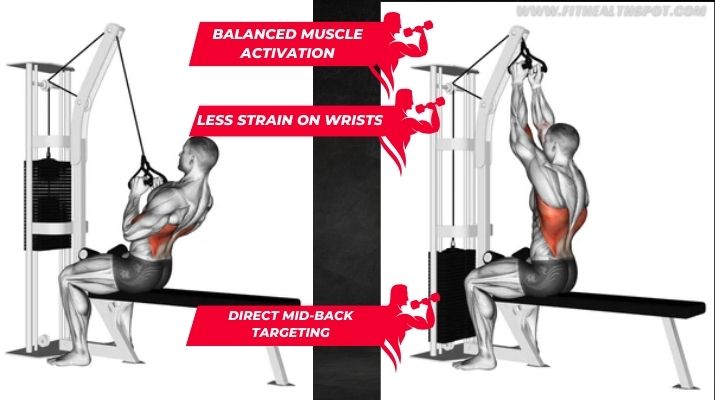
Differentiating the Neutral Grip from Others:
- Grip Orientation: Unlike the pronated (overhand) or supinated (underhand) grips, the neutral grip involves holding the handles with palms facing each other. This often requires a specific bar or handle attachment with a parallel grip.
- Elbow Direction: In the neutral grip, the elbows tend to travel more straightforwardly down by the sides instead of flaring out or being in front of the body.
Technique and Form Details:
- Setup and Grip: Adjust the machine for your size and select the appropriate weight. Grasp the parallel handles so your palms face each other.
- Posture: Maintain an upright seated position with a minor arch in the lower back. Maintain a proud posture, chest soaring high, and your inner strength firmly embraced throughout.
- Pulling Motion: Imagine trying to tuck your elbows into your pockets as you pull the handles down. The motion should be controlled, focusing on squeezing the shoulder blades together at the bottom.
- Return Phase: Gradually release the handles to the initial position, ensuring a full stretch in the lats.
Specific Muscle Areas Targeted:
Like other pulldown variations, the Neutral Grip Lat Pulldown primarily targets the latissimus dorsi. However, due to the grip and elbow orientation, there’s a heightened focus on the middle back muscles, such as the rhomboids and the middle trapezius.
Reverse Lat Pulldown
The Reverse Lat Pulldown often leads to some confusion, given its name. Here’s how it stands out from its counterparts:
What Makes it “Reverse”? The term “reverse” in the context of the lat pulldown isn’t about the grip but the direction in which the bar is pulled. In the traditional pulldown, the bar is pulled down in front of the face, while in the reverse variant, it’s directed down behind the head. While this method can introduce variation, it’s a topic of discussion among fitness professionals because of the potential strain it might exert on the shoulders.
Form, Benefits, and Common Mistakes:
Form:
- Start in a similar position as the standard lat pulldown.
- As you pull the bar down, lean your torso forward.
- Guide the bar behind your neck, making contact with your upper trapezius muscles.
Benefits:
- Altered Muscle Activation: The reverse technique targets the outer lats more prominently, providing a unique muscle activation pattern.
- Variation: It introduces a fresh challenge and diversifies the routine, breaking the monotony of the conventional pulldown.
Common Mistakes:
- Overloading with Weight: Excessive weights can compromise form, increasing injury risk.
- Pulling Excessively Low: The bar should touch the upper traps or the base of the neck. Avoid bringing it down to the mid-back region.
- Personal Suitability: Not everyone should opt for this variant, especially those with prior shoulder issues or limited mobility. Always consult with a fitness expert or physiotherapist if in doubt.
Supinated Lat Pulldown
A grip shift can dramatically change the dynamics and the targeted muscle groups during a workout. The Supinated Lat Pulldown stands as a testament to this fact.
Explanation of the Supinated Grip:
The supinated grip, commonly known as the underhand or reverse grip, requires the palms to face the ceiling or the user’s face. If you’re looking at the back of your hands while gripping the bar, you’ve got the supinated grip right.
Methodology and the Targeted Muscles:
- Setup and Grip: Ensure the machine is correctly adjusted. Grab the bar with an underhand grip, spacing hands about shoulder-width apart.
- Execution: As with other pulldowns, maintain an upright position, retract the scapula, and pull the bar down towards the chest. The final position should have the bar near or slightly below the chin, with elbows pointing downwards and slightly forward.
- Targeted Muscles: While the lats (latissimus dorsi) remain the primary target, the supinated grip also significantly activates the biceps brachii due to the hand orientation. The lower traps and rhomboids also get a decent workout, ensuring a comprehensive back exercise.
Most Common Errors to Watch Out For:
- Over-arching the Back: This could lead to lower back strain. It’s essential to maintain a neutral spine.
- Using Momentum: Swinging or using body momentum diminishes muscle engagement and can cause injury.
- Grip Width: Going too wide or narrow can stress the shoulders and limit muscle engagement. Aim for shoulder width. For readers interested in enhancing their bicep and back workouts, our guide on wrist curls provides insights into a crucial accessory movement that complements the supinated grip.
Rope Lat Pulldown
Moving away from the conventional bar attachments, using a rope for lat pulldowns offers a fresh perspective and a unique challenge to the musculature.
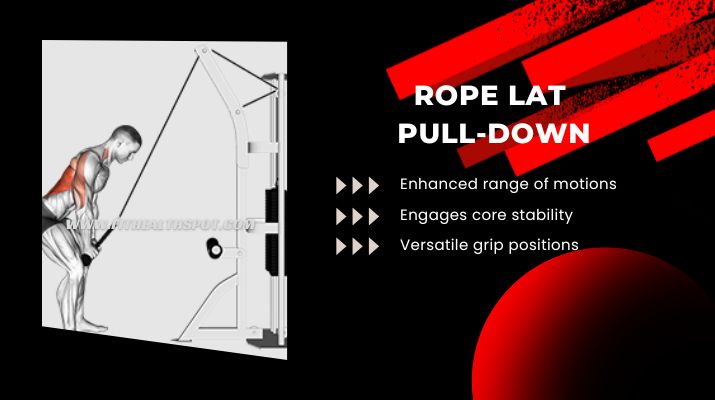
Introduction to Rope as an Equipment Variation:
The rope attachment typically used for tricep pushdowns can be an effective tool for lat pulldowns. This unconventional choice promotes a more extended range of motion and distinct muscle engagement.
How Rope Affects the Pull and Targeted Muscles:
- Enhanced Range of Motion: The rope’s flexibility allows for a deeper pull at the bottom, ensuring a full contraction of the lats.
- Grip Variability: One can adjust grip width seamlessly, targeting different portions of the lats.
- Increased Stabilization: Smaller stabilizing muscles in the back and arms play a more significant role without a rigid bar to pull down.
Technique Details:
- Setup: Attach the rope to the pulldown machine, adjusting the weight as needed.
- Grip: Hold the rope ends with palms facing each other or slightly inward.
- Execution: Keeping an upright posture to pull the rope ends apart and slightly backward ensures maximum lats contraction. This “flaring out” at the bottom of the movement is unique to the rope pulldown and emphasizes the outer lats and teres’ major muscles. Remember to squeeze at the bottom for a moment before controlling the rope back up to the starting position.
- Breathing: Inhale as the rope rises to the starting position and exhales powerfully during the pulldown phase. This breath control aids in maintaining proper form and core stability.
- Elbow Tracking: Ensure your elbows track downwards and in line with the motion. Avoid letting them flare out excessively.
Advantages of the Rope:
- Versatility: The rope allows for small changes in hand positioning during the exercise, catering to individual biomechanics and comfort.
- Engaging Secondary Muscles: With the rope, you might feel more engagement in the brachialis (a muscle in the upper arm) and the forearms due to the gripping nature of the exercise.
Safety Considerations:
As with all exercises, it’s vital to ensure proper form and avoid lifting too heavy too soon, leading to poor technique and potential injuries.
Using different equipment for familiar exercises, like the rope for lat pulldowns, can provide a refreshing challenge and stimulate muscle growth in new ways. For those looking to diversify their workout equipment further, our guide on calisthenics workouts offers insights into bodyweight training that can be integrated with traditional weightlifting practices.
Lat Pulldown with Bands
The evolution of resistance bands has made them an indispensable tool for both gym enthusiasts and home workout warriors. These bands can offer unique advantages and challenges when incorporated into the lat pulldown.
Benefits of Using Resistance Bands in Lat Pulldowns:
- Progressive Resistance: Bands increase tension as they’re stretched, providing more resistance during the peak contraction of the exercise.
- Portability: Perfect for those on the go or without access to traditional gym equipment.
- Joint Health: Bands offer a more joint-friendly resistance, reducing the sudden jolts that weights might produce.
- Versatility: Resistance bands come in various strengths, suitable for beginners and advanced users.
Setup and Execution:
- Setup: Anchor the resistance band overhead using a door anchor or a sturdy overhead object.
- Grip: Hold the band ends or handles with both hands, positioning them as you grip a lat pulldown bar.
- Execution: Sit or kneel, keeping the torso upright. Pull the band ends or handles down towards your chest, squeezing your shoulder blades together. Control the resistance as you return to the starting position.
Potential Mistakes and How to Avoid Them:
- Going Too Fast: Maintaining a controlled motion to fully engage the muscles and avoid snapping the bands is crucial.
- Using a band that’s too light or heavy can hinder proper form. Choose a resistance that allows for 10-15 controlled reps.
- Ensure you stretch the band adequately at the top and squeeze at the bottom for full muscle activation.
To further understand the dynamics of resistance-based workouts, our article on nitric oxide dump exercises gives insights into how resistance exercises, including those with bands, can boost nitric oxide production and enhance workouts.
Kneeling Lat Pulldown
Diversifying one’s workout regime ensures consistent muscle growth and addresses strength imbalances. The kneeling lat pulldown is a testament to this, offering a different engagement pattern for the back muscles.
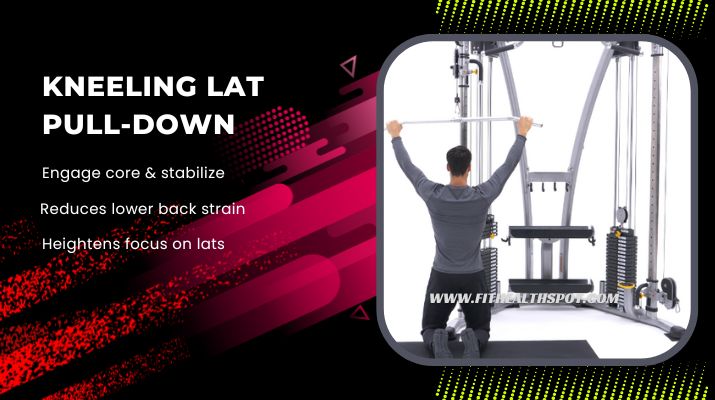
Why and When to Choose This Variation:
- Core Engagement: The kneeling position requires more stabilization, thus engaging the core muscles.
- Reduced Lower Back Strain: Without a seat to leverage against, there’s less temptation to use the lower back during the movement.
- Space-Efficient: It’s a great option for home workouts with limited space.
Form and Technique Breakdown:
- Setup: Adjust the weight on a lat pulldown machine or a cable machine. Position a pad or soft mat on the ground.
- Position: Kneel in front of the machine, gripping the bar with your desired grip.
- Execution: Pull the bar down to your chest, keeping the spine neutral and core engaged. Return the bar slowly to the starting position.
Unique Benefits and Challenges:
- Heightened Muscle Activation: The kneeling might engage the lats differently due to the altered body mechanics.
- Without the assistance of legs and seat, the upper body does most of the work, making it slightly more challenging.
For fitness enthusiasts keen on exploring more variations of traditional exercises, our guide on lunges showcases how a basic movement can be transformed with slight modifications to target different muscle groups.
Equipment Insights
Understanding the equipment is as crucial as mastering the technique. Let’s delve into the primary equipment used in lat pulldowns.
Lat Pulldown Machine
This equipment has been a staple in gyms for decades, offering a targeted approach to training the upper back muscles.

Introduction to the Machine and its Components:
- Stacked Weights: Allow users to adjust resistance easily, catering to all fitness levels.
- Pulley System: Provides smooth and consistent tension throughout the exercise.
- Thigh Pads: These stabilize the user and prevent them from being lifted off the seat during heavy pulls.
- Adjustable Seat: Ensures users of all heights can comfortably use the machine.
How it Compares to Free Weights and Bands:
- Consistency: Machines provide a fixed resistance path, which can be advantageous for beginners or those looking to isolate specific muscles.
- Versatility: Free weights and bands allow for a more natural range of motion and engage stabilizing muscles more, but they require a higher level of skill and control.
- Space & Cost: While machines are more expensive and take up more space, they are often more durable than resistance bands.
Maintenance and Safety Tips:
- Regular Inspection: Check for wear and tear, especially in the cables and pulley systems.
- Cleanliness: Wipe the machine after use to maintain hygiene and longevity.
- Safety: Always adjust the weight stack properly to avoid it from dropping suddenly.
Lat Pulldown Bar
While the machine provides resistance, the bar is where the user interacts directly, making its design and use vital.

Different Types of Bars and Their Uses:
- Standard Straight Bar: The most common type, ideal for wide-grip pulldowns.
- Cambered Bar: It has a slight bend in the middle, allowing for varied grip positions.
- V-Bar: This offers a close, neutral grip for targeting the center of the back.
Proper Grip and Positioning on the Bar:
- Grip Width: Adjust your grip width depending on the desired focus (inner or outer lats).
- Thumb Position: A thumbless or “hook” grip can help emphasize the lats over the biceps.
- Wrist Alignment: Ensure that the wrists remain neutral and aren’t bent during the movement.
Benefits of Using a Dedicated Bar:
- Ergonomic Design: Dedicated bars are crafted to provide optimum hand positioning, reducing strain on the wrists and forearms.
- Varying your grip and bar type can help emphasize different parts of the lat muscles.
To understand how different equipment impacts muscle engagement, refer to our detailed breakdown of hack squat vs. leg press vs. traditional squat.
Benefits of Incorporating Lat Pulldowns in Your Routine
Incorporating lat pulldowns into your regimen is about more than just building an impressive back.
Overall Muscle Development and Strength:
- Upper Back Development: Primarily targets the latissimus dorsi but also engages the rhomboids, trapezius, and rear deltoids.
- Arm Engagement: The biceps, brachialis, and forearms support it, making it a compound exercise.
Postural Benefits:
- Counteract Forward Slouch: Strengthens the muscles that retract the shoulder blades, which can improve posture, especially for those who sit at desks.
- Spine Support: A strong back provides better support for the spine, potentially reducing the risk of back issues.
Advantages for Other Workouts and Daily Activities:
- Foundation for Pulling Movements: Strength gained from lat pulldowns can translate to pull-ups, rows, and other pull exercises.
- Daily lifting, pulling, or reaching activities become easier with a stronger back.
Incorporating exercises that target multiple muscle groups, like the lat pulldown, ensures a balanced workout routine. For more compound exercises, our guide on sumo deadlifts offers a deep dive into an exercise that engages the entire posterior chain.
Common Mistakes & How to Avoid Them
Even the most straightforward exercises can be rendered ineffective or dangerous if done incorrectly. Here are some typical missteps people make when performing lat pulldowns and how to sidestep them.
Rounding of the Back:
- Mistake: Arching or rounding the back can shift tension away from the lats and place unnecessary strain on the lower back.
- Solution: Ensure your back is straight, with a slight natural arch in the lumbar region. Engage your core to provide stability and prevent excessive movement.
Incorrect Grip:
- Mistake: Holding the bar too wide or narrow can decrease muscle engagement or joint strain.
- Solution: Your grip should be wider than shoulder-width for a standard lat pulldown. However, grip can vary based on the variation you’re performing.
Using Momentum Instead of Muscle Strength:
- Mistake: Utilizing the elegant choreography of one’s physique to elegantly steer the weight towards the ground elevates the efficiency of the exercise while diminishing the potential for injury.
- Solution: Use a controlled motion, pulling the bar down with muscle power and releasing it slowly to maintain constant tension on the lats.
Not Engaging the Lats Properly:
- Mistake: Failing to activate the lats, often resulting in overusing the biceps and forearms.
- Visualize your lats doing the work. Initiate the pull from your elbows, thinking of them driving downwards. This mental cue can help in properly activating the lats.
For more information on the correct form and ways to avoid common mistakes in exercises, our comprehensive guide on lunges offers insights into perfecting another fundamental workout move.
Conclusion: Crafting the Perfect Lat Pulldown Routine
With all the variants and techniques at your disposal, how do you mold the perfect lat pulldown routine?
Combining Various Forms for a Comprehensive Workout:
Diversify your grip and form in each session to ensure you’re targeting all areas of your back. For example, integrate the underhand and neutral grip pulldowns in one session.
Recommendations for Beginners vs. Advanced Users:
- Beginners: Start with the traditional lat pulldown to get a feel for the movement. Focus on mastering the technique with lighter weights before progressing.
- Advanced Users: Incorporate variations like the rope and band pulldowns to challenge the muscles differently. Also, experiment with drop sets or supersets to intensify the workout.
Tips for Integration with Other Back Exercises:
- The lat pulldown is just one piece of the puzzle. Combine it with exercises like rows, pull-ups, and face pulls for a comprehensive back workout.
- Always ensure you balance push and pull exercises in your routine. After a session focusing on lat pulldowns and other pull exercises, consider integrating push exercises like push-ups or bench presses in your next session.
- To achieve a well-rounded back workout, consider integrating the lat pulldown with other exercises highlighted in our article on lat workouts. A balanced and varied routine will be key to your back development and overall upper-body strength.
Frequently Asked Questions (FAQs)
Is the lat pulldown effective for building a wide back?
Absolutely. The lat pulldown primarily targets the latissimus dorsi, the broadest muscles in the back. When developed, these muscles contribute to the “V-taper” appearance. Consistency in your training and incorporating various grips and variations of the lat pulldown can enhance the width and definition of your back.
How does the lat pulldown compare to pull-ups or chin-ups?
Both exercises target similar muscle groups, primarily the lats. However, pull-ups and chin-ups use your body weight for resistance, which can be challenging for beginners. Lat pulldowns allow for adjustable resistance, making it a more accessible exercise for those just starting or those looking to target their lats with specific weights. As you progress, integrating both pull-ups and lat pulldowns can provide comprehensive back development
Can I do lat pulldowns every day?
While it’s technically possible, it’s not advisable. Like any muscle group, the lats need time to recover after a workout. Overtraining can lead to injuries and hinder muscle growth. Giving at least 48 hours of rest between intense back workouts is recommended. Focus on a balanced routine for adequate recovery to achieve optimal results.

